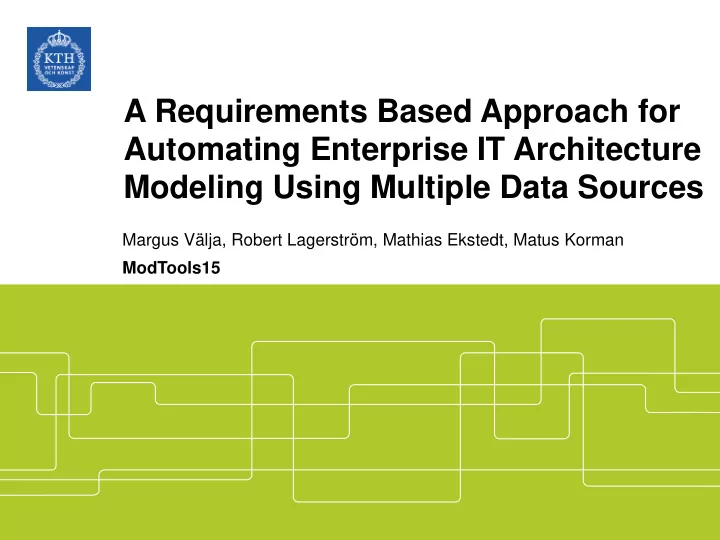

A Requirements Based Approach for Automating Enterprise IT Architecture Modeling Using Multiple Data Sources Margus Välja, Robert Lagerström, Mathias Ekstedt, Matus Korman ModTools15
Outline • Motivation • Methodology • Requirements and Approach • Study • Discussion
Motivation Too complex environments to create models manually (hundreds of devices which each have tens of instances of software) If we would succeed, Timeliness and scalability still problematic
Motivation Too much heterogeneous data and difficult to make sense of it
Motivation: Model Collected Known In progress Known vulnerabilities in existing Configuration methods used for Application protocols software web applications and similar IT management processes’ Computer and network Patch levels of clients, servers and characteristics like for example for hardware with addresses software products zone management process Social aspects like social zone, Access control points and password security awareness program, and Network zones authentication mechanisms developer training Software (also firmware) Software architecture and software including system software assurance methods like static code and operating systems Data flows analysis Types of security controls present like cryptography methods and User accounts port security
Motivation: Data sources Type of tool Examples Type of data Data acquiring method Vulnerability Scanning network, scanners, network Hardware devices, software, computer nodes and Active scanners scanners vulnerabilities application servers Vulnerability scanners, network Hardware devices, software, scanners, packet vulnerabilities, network Listening to existing Passive scanners analyzers communication network traffic Business, Enterprise architecture information, IT Models of organization and management architecture its IT (in different views) Manual input, scanning Change, release, license management, System management directory services TO-BE to AS-IS elements Manual input, scanning IDS, IPS, firewalls, System, network, process Scanning, listening, Security monitors SIEM solutions state information registering security events
Methodology: Earlier work • Model to model transformation standards Extensible Stylesheet Language Transformations (XSLT), Query/View/Transformation (QVT) etc. • Attempts to create EA models (Archimate, CySeMoL) • Business process modelling
Methodology • Requirements • EA model maintenance • Enterprise information credibility • Data cleaning (DW) • IT operational model • EAAT & CySeMoL • XSLT
Approach: Architectural requirements 1. Data collection process needs to be supported by tools to limit manual inspection. 2. Data collection process needs to be extensible to cover additional sources easily.
Approach: Integration requirements 3. The system needs to be able to detect changes in real world enterprise architectures. 4. The system needs to provide a mechanism to define mapping from incoming data to the internal data structure. 5. The system needs to have a machine understandable internal structure.
Approach: Data quality requirements 6. The system needs to provide mechanisms to ensure data quality that is sufficient for the modeling goals including the classification of data sources 7. The data needs to be of appropriate granularity, consistency, completeness and actuality (time), all of which must be measurable. 8. The system needs to allow for the automated propagation of changes. 9. The system needs to be able to identify and resolve data identity conflicts from different sources via reconciliation.
Approach: Data quality requirements 10. As more sources agree an answer, the credibility of that answer should be monotonically non-decreasing. 11. The data source must be known. 12. The data source’s historical credibility must be known.
Approach: human-machine approach One source Multiple sources Description Data acquisition Data acquisition Collecting data for a model Data analysis Decision and action selection Action Implementation Data analysis Data analysis Model based analysis Decision and Decision and action action selection selection Model based action selection Action Implementation Action Implementation Real life consequences
Approach: High level view
Approach: Concerns: Data acquisition Concern Process step Automation What data are needed for Define data needs based on the 1 modeling? metamodel as a common data structure No 2 Where do the data come from? Define data sources No What kind of tools and machine understandable structure should Decide tools and machine understandable 3 be used? format No Which data sources can be 4 trusted and to what extent? Define credibility calculation rules Partial Create adapters to common data 5 How are the data acquired? structure Yes
Approach: Concerns: Data analysis Concern Process step Automation Identify common data quality problems Are there any data quality and define known techniques to solve problems and can these be them (data cleaning workflow and 6 solved? mapping rules) Yes Which data are still missing from the model and can missing data be Identify missing data and define rules 7 derived from existing data? for deriving missing data Partial Are there any patterns that can be 8 reused to improve future models? Define patterns and reuse them Yes How can the processed data be 9 transformed into a model? Apply a transformation method Yes
Empirical study • SCADA lab • 5 servers • 2 Red Hat Systems • 3 Windows • Security analysis • EAAT and CySeMoL • Automatic model generation
Empirical study: Addressing concerns • Data sources Nexpose and Wireshark • Nexpose prioritized over Wireshark • Data exported to XML format and abstracted to right level with adapters
Empirical study: Addressing concerns • Common data structure represents CySeMoL ontology, data quality attributes • Unique identifiers chosen like IP address to merge data • Outside dictionaries needed to complement data • Some data needs to be omitted from the model • EAAT transformation through XLST
Results Calculable model with more than 10000 elements Process can be repeated with new data in minutes
Results: Model
Limitations • Implementation specific details missing • Only certain type of models supported • Manual implementation work
Conclusion • Model creation with multiple sources automated • 9 Concerns need to be addressed
Questions ?
Recommend
More recommend